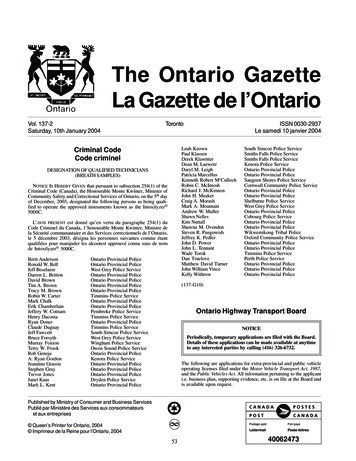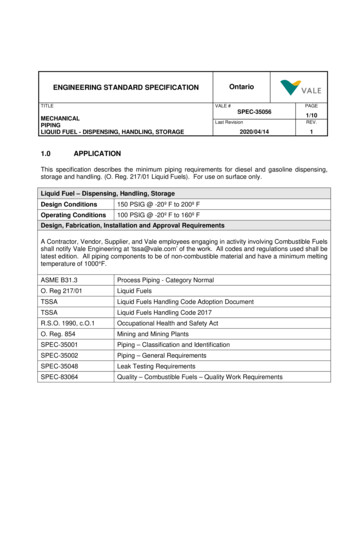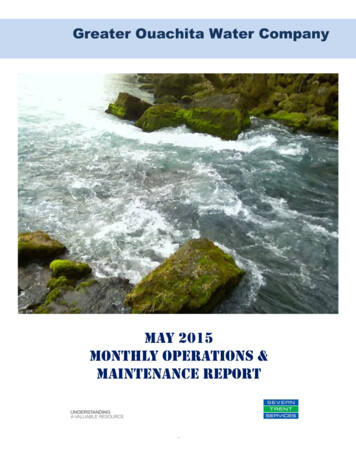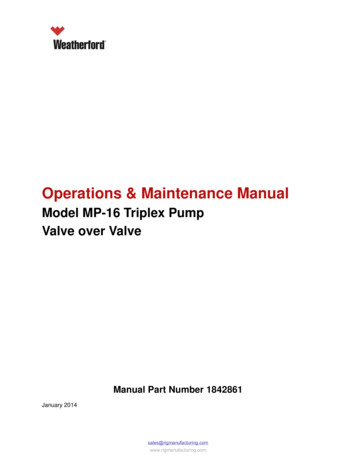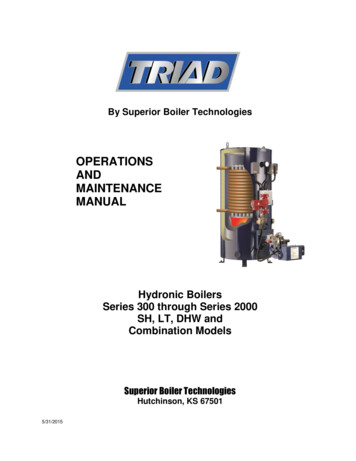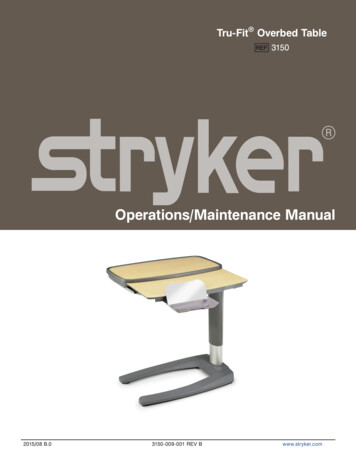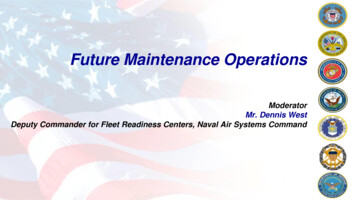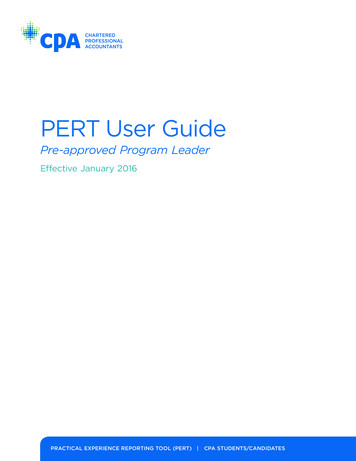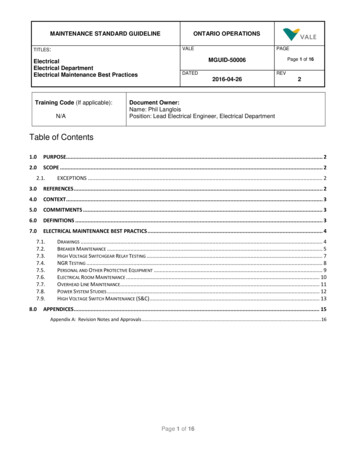
Transcription
MAINTENANCE STANDARD GUIDELINEONTARIO OPERATIONSVALETITLES:ElectricalElectrical DepartmentElectrical Maintenance Best PracticesTraining Code (If applicable):N/APAGEPage 1 of 16MGUID-50006DATEDREV2016-04-262Document Owner:Name: Phil LangloisPosition: Lead Electrical Engineer, Electrical DepartmentTable of Contents1.0PURPOSE. 22.0SCOPE . 22.1.EXCEPTIONS . 23.0REFERENCES . 24.0CONTEXT . 35.0COMMITMENTS . 36.0DEFINITIONS . 37.0ELECTRICAL MAINTENANCE BEST PRACTICS . 47.1.7.2.7.3.7.4.7.5.7.6.7.7.7.8.7.9.8.0DRAWINGS . 4BREAKER MAINTENANCE . 5HIGH VOLTAGE SWITCHGEAR RELAY TESTING . 7NGR TESTING . 8PERSONAL AND OTHER PROTECTIVE EQUIPMENT . 9ELECTRICAL ROOM MAINTENANCE . 10OVERHEAD LINE MAINTENANCE. 11POWER SYSTEM STUDIES . 12HIGH VOLTAGE SWITCH MAINTENANCE (S&C) . 13APPENDICES . 15Appendix A: Revision Notes and Approvals .16Page 1 of 16
Maintenance Standard Guideline1.0ElectricalElectrical DepartmentMGUI-50006 Electrical Maintenance Best Practices Rev 2PURPOSEElectrical maintenance programs vary a great deal from site to site as electrical maintenancemanagement either does not possess the necessary expertise or time to research suchrequirements.This guideline has been created to provide sites with information on best practices to considerwhen setting up an electrical maintenance program to ensure zero harm in the workplace.Where a defined best practice is “required to achieve regulatory or standards compliance”, it hasbeen written in normative (mandatory) language. It is the site’s responsibility to ensure itsprocesses in these areas are in compliance with current legislative requirements and standardsas is applicable.2.0SCOPEThis guideline may be referenced by all Vale Ontario sites.2.1.EXCEPTIONSNone3.0REFERENCESThe following documents were used in the development of this document or are related to it.They shall be used in their most recent revision. CSA-M421-11 Use of electricity in minesCSA-Z462-15 Workplace electrical safetyIHSA/EUSA Infrastructure Health and Safety Association/Electrical Utility SafetyAssociation – rules for utility workNFPA-70B Recommended Practice for Electrical Equipment MaintenanceOSHA Occupational Health and Safety ActRegulation #854 Mines and Mining PlantsCSA Z463-13, Guideline on Maintenance of Electrical SystemsOESC-12, Ontario Electrical safety Code, Part IPage 2 of 16
Maintenance Standard Guideline4.0ElectricalElectrical DepartmentMGUI-50006 Electrical Maintenance Best Practices Rev 2CONTEXTWithout getting into site-specific electrical maintenance requirements or specific programs for allequipment, there are industry accepted “best practices” which should be considered for all Valesites.This guideline identifies best practices including references to federal and provincial guidelines, standards and acts where applicable. Personnel safety and equipment reliability willsuffer if these mandatory requirements are not met.Best practices in this document have been grouped into the following categories:1.2.3.4.5.6.7.8.9.DrawingsBreaker MaintenanceHigh Voltage Switchgear Relay TestingNeutral Grounding Resistor (NGR) TestingPersonal and Other Protective EquipmentElectrical Room MaintenanceOverhead Line MaintenancePower System StudiesHigh Voltage Switch Maintenance (S&C)For each category, a table is provided that provides information in the following format:1. Background2. Applicable requirements (federal or provincial - guidelines, standards, codes or acts)3. Recommended “best practices” approach5.0COMMITMENTSThis guideline (MGUID-50006) is committed to comply with: 6.0The Vale HomeSafe program; andThe Occupational Health and Safety Act.DEFINITIONSBest Practice: Procedures that are accepted or prescribed as being correct or most effective.Page 3 of 16
ElectricalElectrical DepartmentMGUI-50006 Electrical Maintenance Best Practices Rev 2Maintenance Standard Guideline7.07.1.ELECTRICAL MAINTENANCE BEST PRACTICSDRAWINGSBackgroundUpdated drawings permit safe isolation and guide troubleshooters. They assist planners,engineers and consultants thereby reducing ongoing costs.Requirementsmentioned inthe Act,regulations,codes,standards andguidelinesOSHA, 29(2), “ six months ”Reg#854, 22, “ maintained legible ”CSA-M421-11, section 4.2.1, “ annually or after any significant change ”CSA-Z462-15, section 5.2.2, “ single line legible kept current”, Annex B5, AnnexE(3)(i)OESC-12, section#36-006(5), “ metal enclosed switchgear legible single linediagram”CSA Z463-13, section 4.7.5(b), 5.16.2(b)Recommended “BestPractice” approachEach site will appoint a Drawing Coordinator for electrical and instrumentation mark-ups(single lines, schematics and wiring, panel schedules, loop diagrams, layouts, etc.).All drawing revisions are to be channeled through the Coordinator for updating servicesprovided by the Central Engineering Department (CED).The Coordinator will verify the quality of the plant mark-ups and make sure thatreferences are adequate before sending the drawings to CED.When drawings are returned from CED, the Coordinator will distribute the revisions to thecorrect crews (if paper copies are involved, e.g. single lines for posting in electricalrooms).All returned drawings are checked by the Coordinator for missing information or for codeviolations cited by CED and action is taken or scheduled to obtain resolution.Each Site Coordinator will track the missing information and code violation requests tomake sure there is resolution on these matters.CED will track how many drawings have been sent for revision on an annual basis, howmany drawings are returned and the time taken to obtain those revisions. Thesequantities are measurable metrics which can be audited.Page 4 of 16
Maintenance Standard Guideline7.2.ElectricalElectrical DepartmentMGUI-50006 Electrical Maintenance Best Practices Rev 2BREAKER MAINTENANCEBackgroundMaintained breakers assure safe operation when called to do so. During faults, theirtimely action permits the selected PPE to adequately protect the worker and limitoutages to the faulty or overloaded areas only.Requirementsmentioned in theAct, regulations,codes,standards andguidelinesOSHA, 25(2)(h), “ every precaution reasonable ”, 29(1)(a)(ii), “ facilities maintainedas prescribed ”CSA-M421-11, section 4.10, “ electrical equip maintained safety not compromised”CSA-Z462-15, section 5.2.3, section 5.3.5, “ maintained to function in accordance totheir designed operating times”, section 5.6, Annex B12NFPA-70B-10, section 11.10 for low voltage breakers, section 11.16 for high voltage andchapters 15 & 17CSA Z463-13, section#8.2.7 & Table M.4.1 “circuit breakers”OESC-12, section#2-300, “ operating electrical equipment shall be kept in a safe andproper working condition”Recommended“Best Practice”approachThe following services can be supplied by Vale’s Power Department (Protection andControl) in the Sudbury area if the breakers are located on surface. For undergroundbreaker testing, the service must be obtained by non-Vale personnel at the currentstaffing levels.A list will exist which contains all the site’s MCCBs, LVCBs & HVCBs and their scheduledservice intervals. The maintenance paperwork will be kept in an easily accessible area inthe event of ministry investigations.Dated stickers will be affixed to the breakers after servicing.Breakers which exhibit issues during servicing are to be re-serviced three months afterservicing to make sure the issues have gone away.When breakers interrupt faults approaching their interrupting ratings, they shall beinspected before being re-closed.Low Voltage Power Molded-Case Circuit Breakers (MCCBs-600volt) MCCBs are to be serviced every three years. MCCBs which have re-occurring issues are to be removed from service andreplaced by other breakers. The problematic breakers are to be replaced in kind dueto downstream arc flash incident energy level calculated risks on the posted labels. All MCCBs having solid state trip units (such as the RMS-310 & Seltronic) are tohave their units tested using secondary injection. All MCCBs equipped with shunt trips (such as Startco NGR relays) will be trippedusing this feature.Page 5 of 16
Maintenance Standard GuidelineElectricalElectrical DepartmentMGUI-50006 Electrical Maintenance Best Practices Rev 2 All MCCBs equipped with manual trip buttons will be tripped using this feature. All MCCBs will be exercised several times. All MCCBs shall be maintained free of cracks in their cases and cracked or brokenoperating handles. All MCCBs which are suspect or which exhibit hotspots during NDEs will beinspected internally as well. In order to keep the Power Department (Sudbury area only) test equipment inventoryto a minimum, standardize on the following solid state trip units for 600volt MCCBs:Cutler-Hammer Digitrip RMS310 or Seltronic units.Low Voltage Power Circuit Breakers (LVCBs) LVCBs are to be serviced every three years as a minimum (cleaned, exercised,racked-in/out, contact resistance tested, meggered, etc). LVCBs which have re-occurring issues are to be removed from service and replacedby other breakers. The problematic breakers are to be sent for rebuild and notrefurbishment. If sufficient funds permit, consider replacing the defective breaker withanother type of breaker in order to minimize the different styles of breakers at thesite. When selecting other types, select a type which allows the rack in/out processto be done using a racking screw type thereby allowing more distance between theuser and the possible arc flash (permits adding an extension). All LVCBs having solid state trip units (such as the Amptector, I-Tektor, Suretrip andWestrip) are to have their first trip performed electrically using a 9volt battery(terminals OP & ON) or using an alternative method thus proving that the breakerwould have tripped before being serviced. Some older versions having highimpedance trip actuators will not allow this functional test before servicing. All LVCBs having solid state trip units are to have their units tested using secondaryinjection and the settings compared to the posted single line drawings. In order to keep the Power Department (Sudbury area only) test equipment inventoryto a minimum, standardize on the following solid state trip units for 600volt LVCBs:older units are the Westinghouse Amptector and I-Tektor while the newer units arethe Westrip and the Cutler-Hammer Digitrip units. ABB-SACE breakers found onABB-VFDs come with PRC111 trip units. All new trip units should be purchased withthe arc flash maintenance mode feature on them and with LSIG functionality. All LVCBs having dashpot protection will be replaced with breakers having solidstate trip units since dashpots can only be tested using primary injection which apartfrom having serious safety implications, is too costly and cumbersome a program toimplement. These old dashpots are likely missing oil which will cause nuisance tripsor gummed-up causing them to trip slower or not at all. Also, the lack of testing is aliability when personnel are relying on arc flash labels for the proper PPE protection. Local on-hand LVCB spares will be availablePage 6 of 16
Maintenance Standard GuidelineElectricalElectrical DepartmentMGUI-50006 Electrical Main
NFPA-70B-10, section 11.10 for low voltage breakers, section 11.16 for high voltage and chapters 15 & 17 CSA Z463-13, section#8.2.7 & Table M.4.1 “circuit breakers” OESC-12, section#2-300, “ operating electrical equipment shall be kept in a safe and proper working
